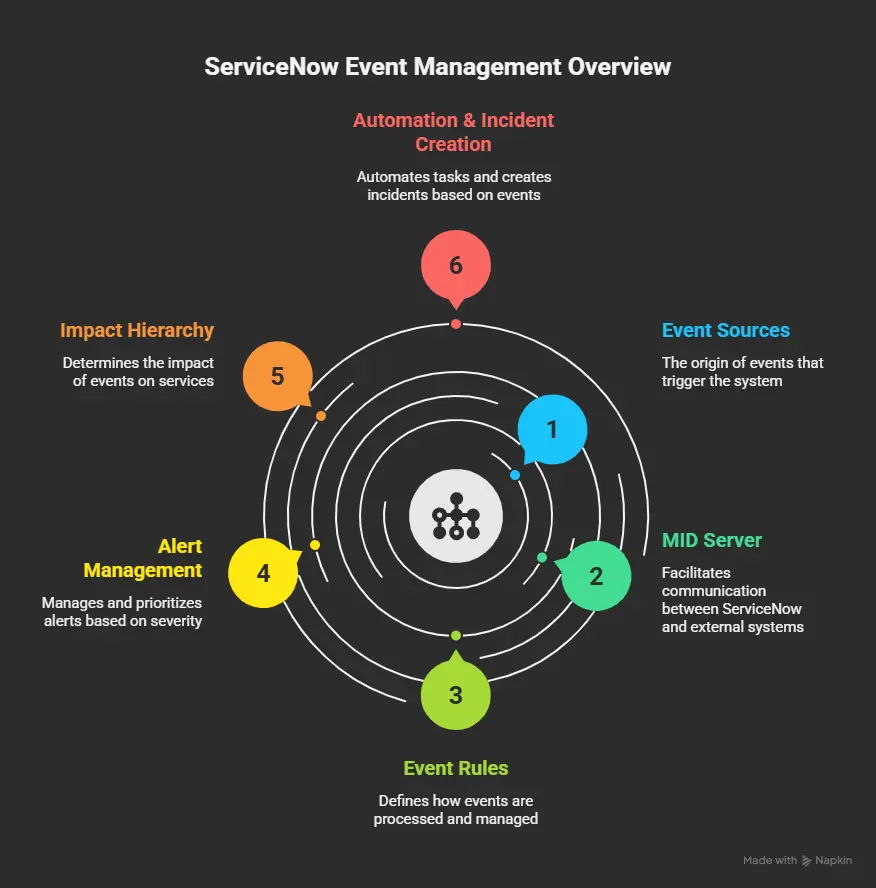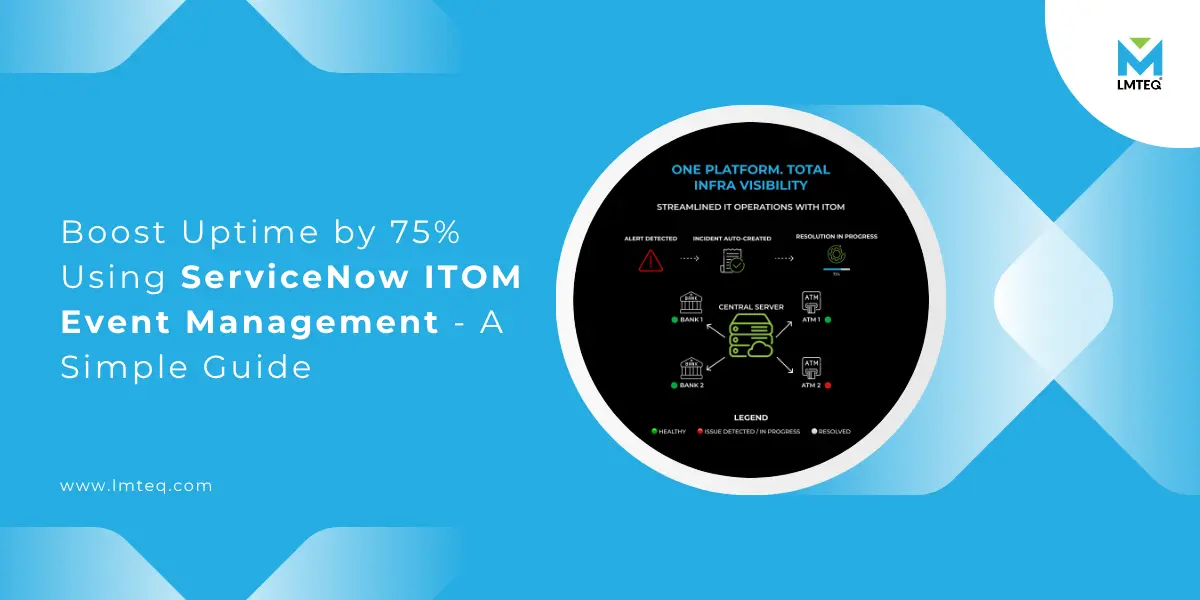Downtime in banking operations is more than just an inconvenience; it’s a direct threat to trust, compliance, and profitability. Every minute a core banking system is down, transactions are blocked, services freeze, and customers lose faith. In fact, recent studies show that the average cost of IT downtime can exceed staggering $9,000 per minute for financial institutions.
So, how can banks avoid these disruptions and proactively manage their IT infrastructure?
Enter ServiceNow ITOM, and more specifically, ServiceNow Event Management—a powerful solution that helps IT teams gain visibility into their environment, prevent failures, and automate incident resolution before customers even notice.
This blog breaks down what ServiceNow ITOM Event Management is, how it works, and how even a beginner can understand and implement its capabilities for resilient, modern operations.
Table of Contents
- What Is ServiceNow ITOM?
- Understanding Event Management in ServiceNow
- Real-World Example – A Banking Data Center
- Key Components of ServiceNow Event Management
- How AI and Automation Supercharge ITOM Event Management
- Benefits of ServiceNow ITOM for Banks and Data Centers
- Getting Started with ITOM in ServiceNow
- Final Thoughts – ITOM Is No Longer Optional in Banking
- Ready to Implement ITOM? Let LMTEQ Help.
What Is ServiceNow ITOM?
ServiceNow ITOM (IT Operations Management) is a suite of applications that allows enterprises to gain complete visibility into their IT infrastructure, automate workflows, monitor system health, and ensure service availability.
It works by consolidating operations data from multiple sources, servers, network devices, cloud platforms, and applications into a centralized, actionable view.
Core Capabilities of the ServiceNow ITOM Suite :-
- ServiceNow ITOM Discovery – Automatically identifies IT assets and maps their relationships.
- ServiceNow ITOM Service Mapping – Creates real-time maps of how infrastructure components support business services.
- ServiceNow Event Management – Detects and prioritizes critical issues in real-time using alerts.
- Operational Intelligence & AIOps – Uses machine learning to predict issues before they occur.
- ServiceNow CMDB – A central repository or a database in the platform that helps to store information about the technical assets or services within the organization.
With ServiceNow ITOM modules, banks can streamline operations, reduce downtime, and proactively address infrastructure issues.
Understanding Event Management in ServiceNow
Imagine you’re operating a bank with hundreds of branches, each with its own servers, ATMs, firewalls, and applications. On any given day, these systems generate thousands of alerts, CPU spikes, disk space warnings, failed backups, or dropped network packets.
Without a centralized system, these alerts become unmanageable noise. That’s where ServiceNow Event Management steps in.
What Exactly Is Event Management?
ServiceNow Event Management is a module within the ServiceNow ITOM Suite that helps organizations detect, consolidate, and prioritize alerts coming from IT infrastructure, applications, and monitoring tools. It takes raw data and turns it into actionable intelligence.
Rather than manually sifting through every alert, the system correlates related events, identifies potential issues, and kicks off automated remediation or notification workflows.
From Alert Chaos to Clarity
Let’s break this down using a practical analogy :-
“Think of your IT systems like a hospital, and alerts are like patient symptoms, fever, cough, shortness of breath. A doctor (Event Management) doesn’t treat each symptom separately. Instead, they correlate them to identify the root illness, pneumonia, and provide targeted treatment.”
Similarly, ServiceNow Event Management helps you to :-
- Filters irrelevant alerts
- Correlates related ones
- Pinpoints the root issue
- Initiates incident creation or resolution workflows
Where Do These Alerts Come From?
Similarly, ServiceNow Event Management helps you to :-
- Nagios, SolarWinds, or Zabbix
- Cloud-native services like AWS CloudWatch or Azure Monitor
- Network and application logs
These alerts are brought into ServiceNow via a MID Server, which acts as a secure bridge between your on-prem systems and the ServiceNow cloud platform.
Correlation and Intelligence
What makes ServiceNow Event Management powerful is its correlation engine. It :-
- Group multiple alerts into a single “alert group”
- Maps events to the services they impact (using Service Mapping)
- Ranks them based on severity and business impact
- Automatically escalates critical incidents
For example :-
“If five different alerts come in, database lag, memory usage spike, and API failures, Event Management might group them into one root cause: a failing DB server. Instead of creating five tickets, it raises one incident for efficient handling.”
Event Life Cycle at a Glance
Here’s how a typical event flows through ServiceNow :-
- Event Triggered – A monitoring tool detects an anomaly.
- Data Transferred – The MID Server sends event data to ServiceNow.
- Event Rules Applied – Events are filtered, normalized, and interpreted.
- Alert Created – A clean, human-readable alert is generated.
- Correlation Kicks In – Alerts are grouped and linked to business services.
- Incident Auto-Created – If needed, the system creates an incident and notifies the team.
- Automation Executed – Predefined scripts or workflows resolve the issue or assist in diagnosis.
Real-World Example – A Banking Data Center
Let’s look at a simplified example of how ITOM in ServiceNow benefits a typical bank.
Scenario :- A core banking database server starts lagging due to a backup process failure.
Without ITOM :-
- Alerts from different systems flood the NOC.
- Manual triage takes hours.
- Root cause is buried under hundreds of unrelated notifications.
With ServiceNow Event Management :-
- Alerts are captured and analyzed by ServiceNow MID Server, which bridges your monitored environment with the ServiceNow platform.
- Event rules identify the backup process failure.
- Correlation logic connects related alerts.
- An incident is auto-created, assigned to the correct team.
- Automation scripts restart the backup process.
- Stakeholders are notified without human intervention.
This demonstrates how ServiceNow ITOM visibility helps reduce resolution time while keeping customer-facing services intact.
Key Components of ServiceNow Event Management

1. Event Sources
2. MID Server
A ServiceNow MID Server acts as a secure communication bridge between your internal systems and ServiceNow.
3. Event Rules
4. Alert Management
5. Impact Hierarchy
6. Automation & Incident Creation
How AI and Automation Supercharge ITOM Event Management
Modern ITOM isn’t just about visibility; it’s about action. ServiceNow’s Event Management leverages both AI and automation to deliver intelligent operations.
How Automation Works :-
- Auto-create incidents based on event rules
- Run remediation workflows (restart services, clear cache, etc.)
- Send notifications to predefined channels (Slack, MS Teams)
How AI Enhances Efficiency :-
- Event correlation using machine learning reduces alert fatigue
- Predictive AIOps anticipates future disruptions based on past patterns
- Automated root cause analysis accelerates resolution
This reduces Mean Time to Resolution (MTTR), minimizes manual effort, and ensures consistent uptime, critical for banks and financial institutions.
Benefits of ServiceNow ITOM for Banks and Data Centers
Business Benefits :-
- Up to 75% reduction in unplanned downtime
- Faster incident response and resolution
- Proactive issue prevention
- Improved SLA compliance
- Better regulatory alignment (e.g., RBI, PCI-DSS)
Operational Gains :-
- Noise reduction through AI correlation
- Clear visibility via dashboards and maps
- End-to-end traceability of incidents
- Real-time data center monitoring
Whether you’re managing hundreds of ATMs or cloud-native fintech services, ServiceNow ITOM can be tailored for complex financial ecosystems.
Getting Started with ITOM in ServiceNow
Prerequisites :-
- A healthy CMDB (Configuration Management Database)
- Defined service models
- Integrated monitoring tools
Implementation Tips :-
- Start with ServiceNow ITOM Discovery to populate your CMDB
- Configure MID servers for secure data collection
- Gradually enable event rules and automation workflows
- Use ServiceNow ITOM overview dashboards for executive visibility
Remember, ServiceNow’s modular architecture allows you to scale as you grow, adding ServiceNow ITOM modules like Service Mapping, Discovery, or Cloud Insights over time.
We strongly advise you to partner with a ServiceNow ITOM consulting and implementation partner for maximum benefits. You can find the partner here.
Final Thoughts – ITOM Is No Longer Optional in Banking
As digital banking, cloud services, and real-time payments grow, the cost of IT failure is only increasing. Traditional monitoring tools alone can’t handle the complexity or volume of modern IT ecosystems.
With ServiceNow ITOM Event Management, banks gain :-
- Holistic infrastructure visibility
- Intelligent incident prioritization
- Automation at scale
- Seamless integration with existing tools
From monitoring remote ATMs to managing tier-4 data centers, ITOM in ServiceNow offers a scalable, AI-driven foundation to modernize operations.
DOWNLOAD OUR FREE RESOURCE HERE → CMDB Readiness Check
With our tailored CMDB readiness checklist, you have taken the first step for peak IT operation efficiency.
Ready to Implement ITOM? Let LMTEQ Help.
At LMTEQ, we specialize in implementing ServiceNow ITOM services in India and globally, with a sharp focus on banking and financial enterprises, telecommunications, and healthcare.
Whether you’re starting with ServiceNow ITOM Discovery, setting up your first MID server, or enabling event management workflows, we bring deep domain and platform expertise.
Let’s work together to prevent outages, protect your reputation, and optimize your operations.
Contact us today to schedule a personalized ITOM readiness assessment.
